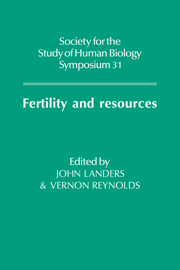Book contents
- Frontmatter
- Contents
- List of contributors
- 1 Introduction
- 2 Environmental and social determinants of fecundity in primates
- 3 Biological aspects of fertility among Third World populations
- 4 A preliminary report on fertility and socio-economic changes in two Papua New Guinea communities
- 5 The cultural context of fertility transition in immigrant Mennonites
- 6 Inter-relationships between consanguinity, religion and fertility in Karnataka, South India
- 7 Resources and the fertility transition in the countryside of England and Wales
- 8 Fertility decline and birth spacing among London Quakers
- 9 Population growth, innovation and resource exploitation
- 10 Fertility decline in developing countries: the roles of economic modernization, culture and Government interventions
- 11 Understanding recent fertility trends in the Third World
- 12 Monogamy, landed property and demographic regimes in pre-industrial Europe: regional contrasts and temporal stabilities
- Index
1 - Introduction
Published online by Cambridge University Press: 13 March 2010
- Frontmatter
- Contents
- List of contributors
- 1 Introduction
- 2 Environmental and social determinants of fecundity in primates
- 3 Biological aspects of fertility among Third World populations
- 4 A preliminary report on fertility and socio-economic changes in two Papua New Guinea communities
- 5 The cultural context of fertility transition in immigrant Mennonites
- 6 Inter-relationships between consanguinity, religion and fertility in Karnataka, South India
- 7 Resources and the fertility transition in the countryside of England and Wales
- 8 Fertility decline and birth spacing among London Quakers
- 9 Population growth, innovation and resource exploitation
- 10 Fertility decline in developing countries: the roles of economic modernization, culture and Government interventions
- 11 Understanding recent fertility trends in the Third World
- 12 Monogamy, landed property and demographic regimes in pre-industrial Europe: regional contrasts and temporal stabilities
- Index
Summary
The relationship between the fertility of organisms and their food supply and other resources has been very extensively studied and forms the subject matter of the science of animal ecology. Studies of this relationship in human beings have had to meet the complication that the food supply of humans is not a fixed resource, but is subject to human manipulation in a number of ways. In addition, food resources, like resources generally, are subject to cultural definition and people in one society may regard as inedible foods that are highly prized elsewhere. While biologists have sought for, and often found, clear relationships between food quality and abundance on the one hand and patterns of fertility on the other, anthropologists, sociologists and demographers have shown that human manipulation of both food production and fertility levels make theory formation much harder in the human case.
In this book a number of biologists, anthropologists and demographers examine how patterns of reproduction are related to the availability of food and other scarce resources in a variety of conditions and circumstances. Dunbar begins by looking at the situation in non-human primates. He points to the importance of social factors as well as the more commonly considered ecological ones. Group size and composition, sex ratio, dominance rank, and membership of coalitions all affect the fertility of female primates. A particular set of proximate mechanisms at the physiological level, especially the actions of prolactin and brain opiates, appear to underlie primate reproductive variance.
Rosetta's analysis of seasonality in a West African subsistence economy emphasizes the phenomenon of food shortage at just the time of year when the harvest occurs.
- Type
- Chapter
- Information
- Fertility and Resources , pp. 1 - 4Publisher: Cambridge University PressPrint publication year: 1990

